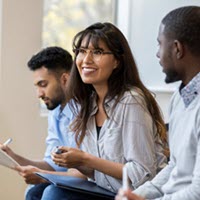
The SABES Program Support PD Center focuses deeply on student leadership as a mechanism for strengthening programs and student persistence. But, are you wondering what student leadership has to do with culturally responsive teaching? The simple answer is, lots!
Adults come to our classrooms with lived experiences that influence their learning. According to this EdWeek article on the relationship between culturally responsive teaching, expectations, and student potential, “culturally responsive teaching means using students’ customs, characteristics, experiences, and perspectives as tools for better classroom instruction.” As stated by SEED (Seeking Educational Equity and Diversity) Founding Co-director Emily Style, “Half the curriculum walks in the door with the students.” As a result, culturally responsive teaching is often seen as the foundation of many asset-based approaches to teaching, which identify students’ cultures and experiences as strengths to be integrated into and built upon through curricula and teaching practices.
A program in which culturally responsive teaching is fostered and valued signals that students’ individual identities are viewed as assets, not barriers. In terms of leadership, we know that conditions that support students’ learning don’t begin or end in the classroom: program policies, practices, and culture all have an important role in shaping student learning and opportunity. Integrating student voice and agency into these areas of our programs is a powerful way to ensure that the principles behind culturally responsive teaching inform every aspect of students’ experiences and learning, and also creates uniquely powerful opportunities for students to see themselves as leaders within and beyond their programs.
What we’re really talking about is co-creating and growing our programs with students instead of for them. Also importantly, we’re talking about learning with and from them.
What does this look like in practice?
We can start by listening to and learning from students to understand what they value, what influences their perceptions of learning and the teacher/student power dynamic, and what expectations they have. This can help us tailor our programs to be more responsive to students’ needs and expectations and thus more inclusive.
What if, for example, we begin by examining and challenging our tendencies to focus on Eurocentric ways of knowing and demonstrating knowledge? These are embedded in many of our expectations around learning and may feel contrary to many learners’ expectations, values, and experiences.
How might holistic approaches, which include bodily, spiritual, and emotional learning, influence our work? As an example, Elizabeth Tisdell recognizes and challenges the power dynamics of race, gender, and class, and promotes the importance of culture, relationships, and spirituality in our classrooms. Somatic ways of knowing, which may be familiar to many of our learners, honor the centrality of bodily experience and spirituality in learning.
Where many Eurocentric cultures value individualism, many other cultures value collectivism. The distinction between individual and communal learning may resonate with many adult educators. What we might consider “cheating” might be seen by students as collaboration in the pursuit of shared learning. This doesn’t even begin to consider how we might all benefit from and enjoy learning about new traditions, languages, and customs.
How do these approaches help us imagine new and different ways for students to engage in and demonstrate their learning?
Our students can be an important source of learning in this area. Understanding their educational experiences and cultural expectations around teaching and learning can expand our own thinking and help us evolve into more responsive, effective teachers.
In December, we presented Student Leadership: Leveraging the Power of Student Voice. While our panelists and the programs they represent are diverse in their approaches to student leadership, they all saw students as partners in building a program, shared a willingness to go beyond what does exist to imagine what could exist, and created a clear structure to shepherd that vision into reality. If you missed this PD offering, you can access the recording and materials.
If you’re interested in developing a student leadership opportunity within your program and would like to brainstorm ideas, the PS PDC offers individualized, program-based PD and coaching to support you in this process. Please reach out to Alexandra Papagno, PSPDC PD Specialist, at alexandra_papagno@worlded.org for more information.
Visit the PS PDC On-demand Site for our collection of recorded professional development!


